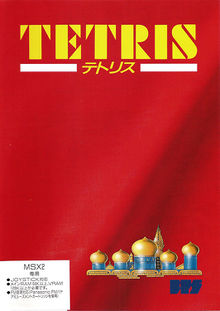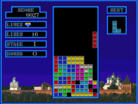Tetris (BPS): Difference between revisions
No edit summary |
mNo edit summary |
||
| (16 intermediate revisions by 3 users not shown) | |||
| Line 1: | Line 1: | ||
{{Infobox |title = Tetris | {{Infobox |title = Tetris | ||
|developer = [[Bullet | |developer = [[Bullet Proof Software]] | ||
|publisher = Bullet | |publisher = [[Bullet Proof Software]] | ||
|released = 1988 | |released = {{release|JP|November 18, 1988}} | ||
|platform = PC-8801, PC-88 VA, PC-9801, X1, X68000, FM-77, FMR, MSX2 | |platform = PC-8801, PC-88 VA, PC-9801, X1, X68000, FM-77, FMR, MSX2 | ||
|preview = 1 | |preview = 1 | ||
| Line 8: | Line 8: | ||
|hold = No | |hold = No | ||
|hard = Hard only | |hard = Hard only | ||
|system = | |system = | ||
|ingame-scrn = Tetris_(BPS)_ingame.png | |||
|title-scrn = Tetris_(BPS)_title.png | |||
|boxart = Tetris_(BPS)_boxart.jpg | |||
}} | }} | ||
'''''Tetris''''', developed by Bullet-Proof Software, was the first licensed game to be released commercially in Japan. It was released | '''''Tetris''''', developed by Bullet-Proof Software, was the first licensed game to be released commercially in Japan. It was released on most of the common home computers from the era. | ||
A [[Tetris (Famicom)|Famicom port]] was released in December. | A [[Tetris (Famicom)|Famicom port]] was released in December 1988. | ||
== Gameplay == | == Gameplay == | ||
The game is split into six rounds | The game is split into ten stages of six rounds each. Drop speed increases with each stage, while each round starts with higher amounts of garbage. Each stage is completed after 25 lines are cleared, after which the playfield is reset. Topping out will cost the player one of their three lives. The game ends after all three lives are lost. | ||
=== Scoring === | === Scoring === | ||
Line clears are scored as follows: | Line clears are scored as follows: | ||
{| | {| class="wikitable" | ||
! Line clear || Points | ! Line clear || Points | ||
|- | |- | ||
| Line 40: | Line 41: | ||
== Versions == | == Versions == | ||
=== Fujitsu FMR50 === | |||
Programmed by Takashi Sakamoto. | |||
=== Fujitsu FM-77 AV === | |||
Programmed by Yoshitaka Yamamura and Tatsuya Kitamura. | |||
=== MSX2 === | |||
Programmed by Tomokazu Hasegawa. | |||
=== | === NEC PC-88 === | ||
Programmed by Richard C. Rogers. | Programmed by Richard C. Rogers. | ||
=== PC- | |||
Programmed by Richard C. Rogers. | === NEC PC-98 === | ||
=== X68000 === | Programmed by Richard C. Rogers, an enhanced version of the PC-88 port. | ||
=== Sharp X68000 === | |||
Programmed by Takashi Sakamoto. The programmer left a developer message referencing JoJo's Bizarre Adventure. | Programmed by Takashi Sakamoto. The programmer left a developer message referencing JoJo's Bizarre Adventure. | ||
This version doesn't correct for CPU clock speed; emulators should be set to 10MHz for correct performance. | |||
=== X1 === | === Sharp X1 === | ||
Programmed by Yoshiharu Kawai. | Programmed by Yoshiharu Kawai. | ||
== External links == | == External links == | ||
*[https://archive.org/details/Tetris1988BPSJP Manual on the Internet Archive] | *[https://archive.org/details/Tetris1988BPSJP Manual on the Internet Archive] | ||
[[Category: | {{Bullet-Proof Software games}} | ||
[[Category:Official Tetris games]] | |||
[[Category:Classic computer games]] | |||
Latest revision as of 01:30, 25 February 2023
| Tetris | |
|---|---|
 | |
| Developer(s) | Bullet Proof Software |
| Publisher(s) | Bullet Proof Software |
| Platform(s) | PC-8801, PC-88 VA, PC-9801, X1, X68000, FM-77, FMR, MSX2 |
| Release |
|
| Gameplay info | |
| Next pieces | 1 |
| Playfield size | 10 × 20 |
| Hold piece | No |
| Hard drop | Hard only |
Tetris, developed by Bullet-Proof Software, was the first licensed game to be released commercially in Japan. It was released on most of the common home computers from the era.
A Famicom port was released in December 1988.
Gameplay
The game is split into ten stages of six rounds each. Drop speed increases with each stage, while each round starts with higher amounts of garbage. Each stage is completed after 25 lines are cleared, after which the playfield is reset. Topping out will cost the player one of their three lives. The game ends after all three lives are lost.
Scoring
Line clears are scored as follows:
| Line clear | Points |
|---|---|
| 1 (single) | 40 |
| 2 (double) | 100 |
| 3 (triple) | 300 |
| 4 (tetris) | 1200 |
If the piece was hard dropped, an amount equal to the number of rows covered by the hard drop plus 1 is added. Otherwise, no score for dropping is added.
Points are only totalled up either after the stage is cleared or if a life is lost.
Versions
Fujitsu FMR50
Programmed by Takashi Sakamoto.
Fujitsu FM-77 AV
Programmed by Yoshitaka Yamamura and Tatsuya Kitamura.
MSX2
Programmed by Tomokazu Hasegawa.
NEC PC-88
Programmed by Richard C. Rogers.
NEC PC-98
Programmed by Richard C. Rogers, an enhanced version of the PC-88 port.
Sharp X68000
Programmed by Takashi Sakamoto. The programmer left a developer message referencing JoJo's Bizarre Adventure.
This version doesn't correct for CPU clock speed; emulators should be set to 10MHz for correct performance.
Sharp X1
Programmed by Yoshiharu Kawai.
External links
| ||||||||

